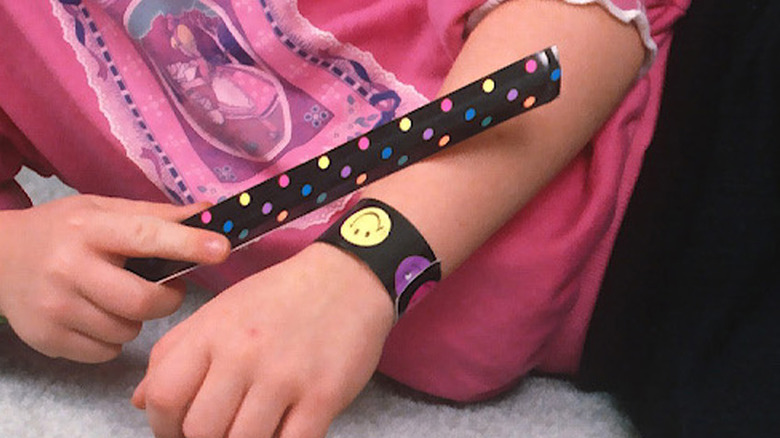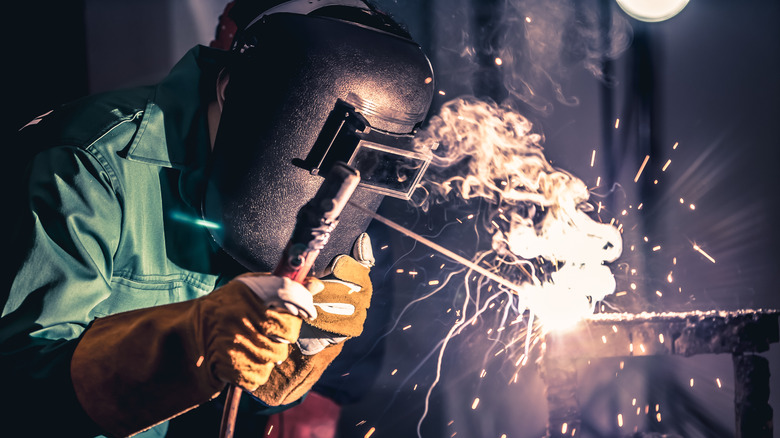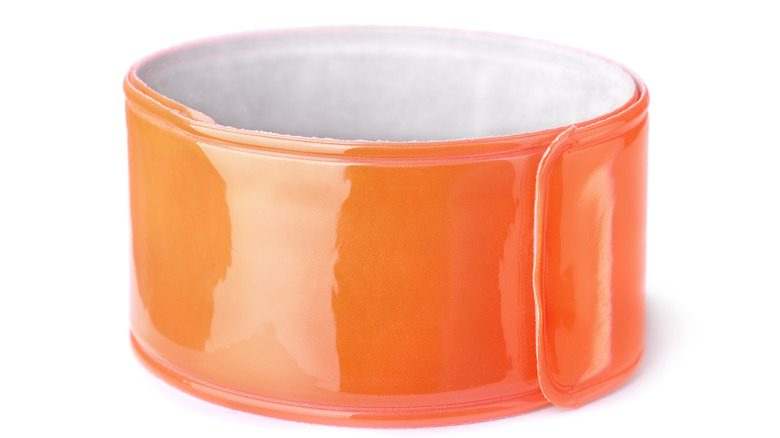What Happened To Slap Bracelets?
An early '90s classroom would not have been complete without one or more of the following: An open Trapper Keeper holding lined paper emblazoned with that weird bubble-letter "s" running down the side, heavy textbooks covered in masterfully folded brown paper bags and decorated in Lisa Frank stickers, mechanical pencils softly clicking in the background, and of course, the sound of steel wrapped in fabric snapping against human skin.
Oh yes, the snap bracelet is also referred to as a slap bracelet because when it is clasped around an arm, it smacks like a heavy hand hitting a face. It was all anyone could hear in the early '90s, back when grade school hallways emitted the unmistakable aroma of CK One and Mariah Carey's popularity was at its peak. It was during this unmistakable moment in human history that the quirky, tween-serving accessory thrived on the wrists of cool girls in butterfly clips everywhere. But then, seemingly with a flick of the wrist, snap bracelets simply snapped out of existence (via Bustle). What really happened to them?
Snap bracelets came to us courtesy of high school shop teacher Stuart Anders
In an archived periodical, The New York Times reports that the snap bracelet, originally called the slap wrap, was invented in 1983 by high school shop teacher and Wisconsin native Stuart Anders. One can only imagine the look of pure glee that must have graced this savvy shop teacher's face once he figured out that he could mold fabric and steel in such a way that when slapped against a wrist, it would wrap tightly around it with a precise, ungiving hold — a bit like a boa constrictor — and instantly make every outfit cooler.
Like most overnight sensations, the success of the snap bracelet was 10 years in the making. The crafty creation would rise to mainstream popularity in the '90s just as the cool kids were hopping off their Skip-Its and searching for bigger, better things. After receiving millions of orders for the product, which was being marketed by word-of-mouth alone, Anders partnered up with Main Street Toys in the hopes that his invention would fall "somewhere between Pet Rocks and the Hula Hoop" (per The New York Times). In 1990, Anthony Ramirez, the New York Times reporter who originally covered the story, declared that snap bracelets were "almost certainly doomed to a short life." He turned out to be right, but not for the usual reasons most items fall out of fashion.
They had serious safety issues from the beginning
According to The New York Times, Main Street Toys was a company founded by former Coleco employees who had vowed to learn from previous mistakes. From the bankruptcy and defeat of previous trendy tween items that ultimately drove Coleco into the ground, they built what they hoped would be a safer foundation. By this point, these dedicated employees understood that some items were fated to be flashes in the pan. With the snap bracelet, their goal was to ride the flash as long as possible. However, there was a flaw.
The original slap wraps were designed from flimsy, thin steel that was able to rip through the fabric it was covered by, exposing a pointy jagged slab that could injure the wearer. The fix was simple: Main Street Toys merely thickened the steel by .002 inches, from .004 inches to .006 inches. The adjustment was slight, but it made a huge difference in product safety and only fractionally drove up the cost. Unfortunately, the time Main Street Toys needed to adjust their product gave copycat companies the leeway to market knock-offs that were based on the flawed original design. By 1990, the market was flooded with jagged little bits of steel knock-off bracelets poised to snap and puncture unsuspecting tweens. This was a disaster.
First, the bracelets were banned in schools across the country
As soon as the snap bracelet craze hit classrooms, the incessant sound became an instant irritant for teachers. There is a bit of irony here, given it was a teacher who was responsible for this annoyance in the first place. The trendy neon slap-on accessories were a bit like a fidget spinner you wear around the wrist — every nervous twitch, every awkward silence, every accidental gaze at somebody's crush equaled yet another snap echoing out in class.
It wasn't long before teachers organized in protest against the disreputable bracelets (via Mental Floss). In New York, the Siwanoy School and the Colonial School banned snap bracelets for safety concerns following an incident that left a West Orchard Elementary School student cut. Pennsylvania's Lehigh Township Elementary School followed suit but gave distraction as the reason. Pretty soon, controversy and school bans were following the snap bracelet everywhere it went. In a way, this added to the appeal but ultimately caused them to fade out of fashion altogether.
Then, they were recalled
Throughout their flash-in-the-pan existence, snap bracelets — and the cheap copycat items disguised on the consumer market as snap bracelets — were not only banned but also recalled. According to Mental Floss, after several reported injuries, the Consumer Product Safety Commission began issuing warnings to parents and teachers, urging them to check the bracelets for signs of fraying fabric and other potential hazards. This discouraged future sales.
Main Street Toy Company President Eugene Murtha began quarreling with inventor Stuart Anders and his agent Philip Bart over unpaid royalties and production delays. The company blamed the knock-offs for the many snap bracelet-related injuries, but the purchasing public didn't care who was to blame, and attempts at reviving these ill-fated fashion staples were met with similar results. In August 2012, 89,500 Toysmith snap bracelets were recalled "due to laceration hazard" (via US Consumer Product Safety Commission). Then, in 2018, over 22,000 Cat & Jack snap bracelets sitting on the shelves at Target were recalled as well (per Good Housekeeping).
Today, snap bracelets hold a hard-earned place in '90s history
Some trends faded out because they were too inconvenient, expensive, or outrageous to remain in style for long. Strangely, though, this is not the snap bracelet's story at all. While not as deadly as the notorious green Victorian dresses that could kill entire rooms of people, nor as environmentally damaging as the aerosol hairspray hairstyles of the '80s that nearly destroyed the ozone layer (per Understanding Science), snap bracelets were certainly the tweenie bopper version of a fashion find that was popular because it was dangerous (and also in spite of that fact). They will forever be associated with other trendy, questionable products of that iconic time.
As such, these colorful, snappy accessories will always hold a hard-earned spot in '90s nostalgia and general fashion history. It is likely that they will not be on the wrist of classrooms filled with 12-year-olds ever again, but it was fun while it lasted.





